Distal femoral fractures
INTRODUCTION
Surgeons have understood the complexities of treating distal femoral fractures in the elderly for many years, but it has only been in the last 30 years that different fixation techniques and their outcome have been examined in detail. Wade and Okinaka1 in 1959 reported on 23 patients with supracondylar femoral fractures, of which 18 were in women and the majority were in their eighth decade. They stated that the predisposing causes of fracture were osteoporosis, pre-existing disabilities of the hip and knee and other medical comorbidities.
The majority of their patients were managed non-operatively with skeletal traction, but they observed that internal fixation was often required for displaced intercondylar or ‘shattered’ fractures. They noted that the mortality and the time patients spent in hospital were very similar in both patient groups, although they thought that patients treated surgically often had greater comorbidities. They favoured using a blade plate for operative management, but they also used intramedullary nailing.
One might ask how much has changed since Wade and Okinaka’s study?1 Chapter 1 shows that the prevalence of osteoporotic fractures has increased with greater life expectancy and it seems likely that many of the elderly patients who present with distal femoral fractures will be even less fit than 50–60 years ago. Surgical techniques have essentially remained the same, although blade plates have largely been replaced by locking plates, which are now often inserted through a submuscular approach, and the intramedullary nails available today are superior to the Küntscher nails used by Wade and Okinaka.1 In addition, primary arthroplasty is often used nowadays to treat distal femoral fractures. One problem which has occurred since Wade and Okinaka’s classic study is that of periprosthetic distal femoral fractures. These are becoming progressively more common.
EPIDEMIOLOGY
Kolmert and Wulff2 analyzed the epidemiology of distal femoral fractures in Malmö, Sweden, in 1969–1976. They stated that distal femoral fractures accounted for 4% of all femoral fractures and had an incidence of 5.1/105/year in patients >16 years of age. They pointed out that 84% of fractures occurred in patients >50 years of age and that in patients >60 years of age, 87% occurred in females. In their group of 135 patients, 19% had had impaired function in both legs and 42% had impaired function in the affected leg because of disease or previous fractures.
Analysis of fracture epidemiology in Edinburgh, Scotland, in a 1-year period in 2010/2011 shows that distal femoral fractures still account for 4% of femoral fractures, but their incidence in patients ≥16 years of age was 7/105/year suggesting that the incidence of distal femoral fractures has increased in the last 30–40 years. In Chapter 1 distal femoral fractures were shown to comprise 0.9% of fractures in patients aged ≥65 years and 1.2% of fractures in patients aged ≥80 years. Their incidence in males and females aged ≥65 years was 8.4/105/year and 30.1/105/year, respectively, with the equivalent incidences in the 80+ year group being 20.1/105/year and 64.0/105/year. They have a type II pattern (see Chapter 1) with increasing age between 65 and 90+ years correlating with increasing fracture incidence in females but not in males. To permit a more detailed assessment of the epidemiology of distal femoral fractures in the elderly, a 15-year study of all distal femoral fractures admitted to the Royal Infirmary of Edinburgh between 1996 and 2010 was undertaken. The Royal Infirmary is the only hospital admitting trauma in a population of about 520,000 adults aged ≥16 years. During this period 392 patients were admitted of whom 271 (69.1%) were ≥65 years of age. The average age of all patients who presented with a distal femoral fracture was 69.3 years. The average ages of the patients who presented with AO/OTA type A, B and C fractures were 74.3 years, 59.2 years and 62.9 years, respectively, indicating a higher prevalence of high energy type B and C fractures in younger patients. The average age of patients who presented with distal femoral periprosthetic fractures was 78.7 years.
A total of 186 (68.3%) patients aged ≥65 years presented with AO/OTA type A supracondylar fractures, while 31 patients (11.6%) presented with type B condylar fractures and 54 patients (20.1%) had type C intercondylar fractures.
Figure 37.1 shows the fracture distribution curves of the different types of distal femoral fracture. The overall distribution curves show a marked increase in fracture incidence in females aged >85 years, whereas the incidence in males is much lower and tends to decline after 80 years of age.
Figure 37.1 shows that the fracture distribution curves for type A supracondylar fractures are virtually identical to the overall fracture distribution curves, emphasizing the importance of this fracture in the elderly population. However, the fracture distribution curves for type B and type C fractures are different. Elderly females show the same increasing incidence with increasing age, but in type B fractures the incidence in males declines after 85 years and in type C fractures the incidence declines after 70 years of age. In the 15-year study there were no intercondylar fractures in males aged >80 years. This suggests increasing male frailty compared with elderly females. Periprosthetic fractures have similar fracture distribution curves to type B and C fractures with an increasing fracture incidence in older females and a decline in incidence in males over 80 years of age.
Overall, 92.9% of patients aged ≥65 years in the 15-year study sustained their fracture as a result of a standing fall, with a further 3.7% having a spontaneous fracture. It is interesting to observe that there were no metastatic distal femoral fractures, although 8.7% of patients aged 50–64 years who presented with distal femoral fractures in the same time period had metastatic fractures. Only 1.5% of distal femoral fractures in the ≥65-year-old group occurred as a result of high energy injuries with 25% of these following a fall from a height and 75% following a road traffic accident.
Both Wade and Okinaka1 and Kolmert and Wulff2 pointed out that many elderly patients who present with distal femoral fractures will often be infirm and in poor health. This continues to be the case and analysis of the data in the 15-year study shows that only 64.9% of patients lived at home, 9.7% were in residential care and the remaining 25.4% were in a nursing home or a hospital when they sustained their fracture. Only 22.4% of the patients walked normally without aids prior to the fracture. A further 28% used one or two walking sticks, 28.7% used a walking frame and 15.7% were in a wheelchair. The remaining 3.7% were bed bound. The older age of the patients with the distal femoral periprosthetic fractures probably accounts for the fact that while 67.7% lived at home, only 16.6% walked without aids.
OPEN FRACTURES
Open distal femoral fractures are very rare in the elderly population. A review of the 271 distal femoral fractures treated in the 15-year period showed that only six (2.2%) were open. There were five (2.7%) open supracondylar fractures, one (3.2%) open condylar fracture and no open intercondylar fractures. The overall incidence of open fractures in the ≥65-year-old patients was 0.4/105/year with 0.2/105/year being recorded in males and 0.6/105/year in females. There were no Gustilo3 type IIIb fractures confirming the low energy nature of these fractures in the elderly. There were three Gustilo type I, one Gustilo type II and two Gustilo type IIIa fractures. Four followed a fall and two resulted from road traffic accidents.
CLASSIFICATION
A number of classification systems have been devised, but the one that is used by most surgeons nowadays is the AO/OTA classification which was originally proposed by Müller et al.4 In this classification the first number refers to the femur (3), the second number refers to the location within the femur (3) and the letters A, B and C refer to the type of fracture. A is an extra-articular fracture, B is a partial articular fracture and C is a complex articular fracture. The subsequent numbers 1–3 refer to the morphology of the fracture with 0.1 to 0.3 detailing the morphology more precisely. The AO/OTA classification is given in Table 37.1 and an illustration of the fracture types is shown in Figure 37.2. An example of an AO/OTA 33A3.2 distal femoral fracture is shown in Figure 37.3.
ANATOMY
The supracondylar area of the femur is the area between the femoral condyles and the junction of the metaphysis with the femoral diaphysis. It comprises the distal 15 cm of the femur. The shaft of the femur is almost cylindrical, but at the lower end it broadens into two curved condyles (Figure 37.4a). The distal femur is trapezoidal and is narrower anteriorly than posteriorly. Medially there is an angle of inclination of about 25 degrees. Anteriorly the two condyles form a joint for articulation with the patella. Posteriorly they are separated by a deep intercondylar fossa that gives attachment to the cruciate ligaments. The lateral epicondyle arises from the lateral condylar surface and gives rise to the lateral, or fibular, collateral ligament. Distal to the lateral epicondyle is an oblique groove for the popliteus tendon. The medial epicondyle gives attachment to the medial, or tibial, collateral ligament and the abductor magnus tendon inserts into the adductor tubercle. When the distal femur fractures, the pull of the quadriceps and hamstrings leads to limb shortening and a varus deformity. The pull of the gastrocnemius, which arises from the lateral and medial femoral condyles, leads to apex posterior angulation. This is shown in Figure 37.3.

Figure 37.1 Fracture distribution curves for distal femoral fractures.
The nerves and arteries at risk following distal femoral fracture and reconstructive surgery are shown in Figure 37.4b. The popliteal artery and vein run through the popliteal fossa which also contains the tibial nerves. The common peroneal nerve, the other terminal branch of the sciatic nerve, arises just above the popliteal fossa and descends along the lateral border of the fossa. It runs over the lateral head of the gastrocnemius and around the neck of the fibula before it divides into the superficial and deep peroneal nerves.
Table 37.1 AO/OTA classification of distal femoral fractures
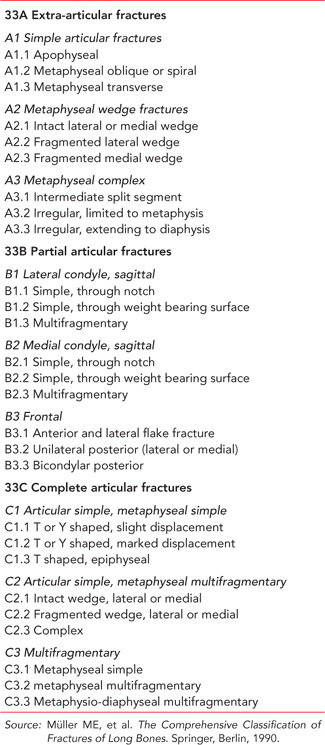
SURGICAL APPROACHES
Lateral approach
This is probably the most commonly used approach to the distal femur. It can be undertaken with the patient placed supine or laterally. The skin incision is along the mid-lateral line of the femoral diaphysis. Distally it is curved anteriorly to over the centre of the lateral condyle. The iliotibial band is incised and the vastus lateralis elevated from the linear aspera and the femur. If necessary a lateral arthrotomy can be undertaken to facilitate treatment of type B or type C fractures.
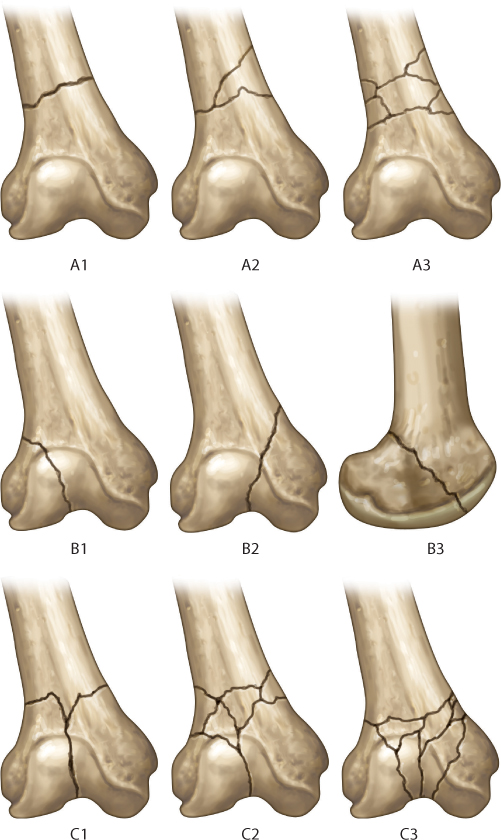
Figure 37.2 The different types of distal femoral fractures as defined by the AO/OTA classification. (From Müller ME, et al. The Comprehensive Classification of Fractures of Long Bones. Springer, Berlin, 1990.)
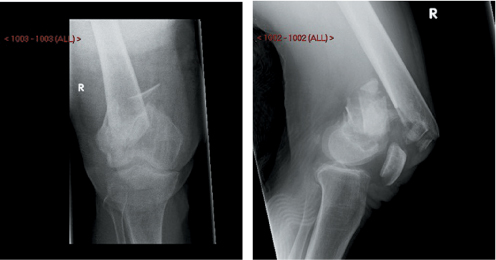
Figure 37.3 Anteroposterior and lateral X-rays of an AO/OTA A3.2 distal femoral fracture. Note the marked metaphyseal comminution and posterior displacement of the distal fragments.
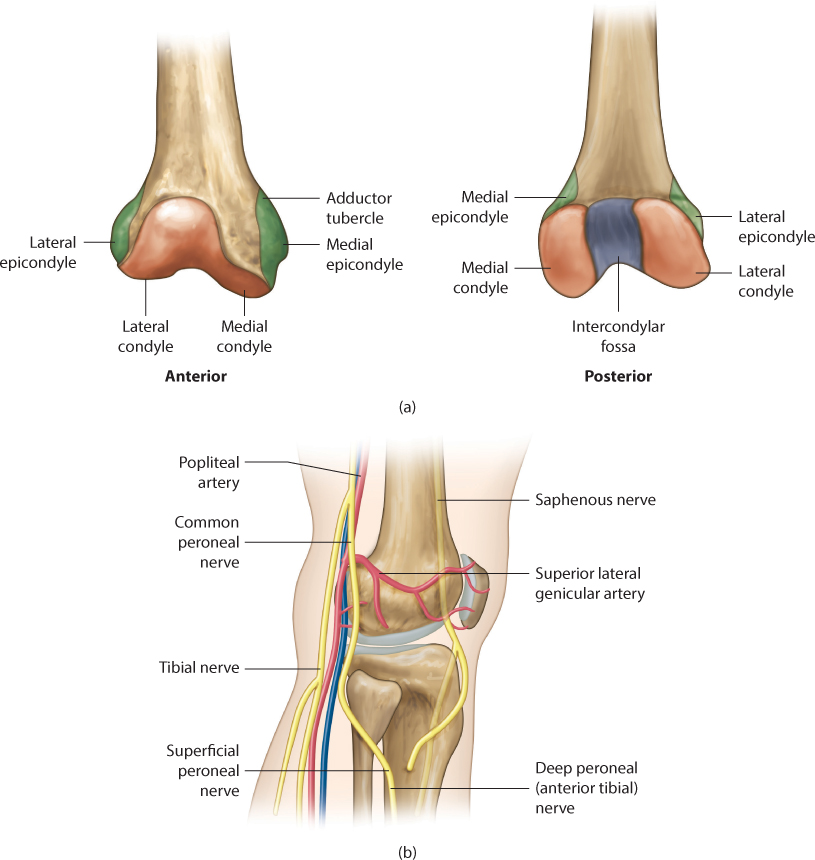
Figure 37.4 (a) Anatomy of the distal femur. (b) Anatomy of the blood vessels and nerves at risk during surgery.
Minimally invasive lateral approach
This approach has become more popular in recent years as it is associated with less soft tissue stripping. It employs a shortened skin incision which measures 5–6 cm and is confined to the area of the lateral condyle and distal metaphysis. The iliotibial band is incised and the distal femur exposed. The plate is slid in submuscularly and small proximal stab incisions used to insert the screws under radiological control.
Medial approach
This is used for open reduction and fixation of medial condylar fractures. The skin incision is in the line of the tendon of adductor magnus. The adductor tubercle is identified and the tendon is followed proximally, but it should be remembered that the femoral vessels pierce the adductor magnus 10–12 cm above the knee joint. The vastus medialis is retracted and the distal femur is exposed. Care should be taken to stay anterior to the medial collateral ligament and to avoid damage to the medial meniscus.
Approach for retrograde intramedullary nailing
A longitudinal midline skin incision is made 2 cm distal to the inferior pole of the patella. The patella tendon is retracted laterally and the medial tissues are dissected. A guide wire can now be inserted medial to the patella. The anatomical landmark is the Blumensaat line, which corresponds to the roof of the intercondylar notch. Care should be taken not to damage the posterior cruciate ligament and the articular cartilage. If preferred, an anteromedial incision can be used and if a type C fracture is to be treated, some surgeons prefer an anterolateral approach.
TREATMENT
As has already been pointed out, the treatment methods that can be used for distal femoral fractures have changed little in 50–60 years,1 although there has been considerable improvement in plate and nail design, with locking plates now being preferred by most surgeons. Arthroplasty is also a new treatment method which seems to be gaining in popularity. The role of non-operative management has changed considerably. It is salutary to note that in 1984 the second edition of Rockwood and Green recommended that closed treatment was suitable for many distal femoral fractures, particularly if they occurred in older patients.5 Traction was still extensively used despite the fact that earlier publications had shown that internal fixation tended to give better results.5,6 and 7 It is always difficult to know how popular different treatment methods are and the assumption must be nowadays that most patients are treated by internal fixation or arthroplasty if they are older. To investigate this we analyzed the types of treatment employed during the 15-year study of distal femoral fractures in the elderly undertaken in the Royal Infirmary of Edinburgh. This is shown in Table 37.2. We were surprised that 30% of the patients were treated non-operatively. No traction was used, but it is clear that many patients with undisplaced or minimally displaced fractures were treated with a cast or brace. Table 37.2 shows that the patients treated non-operatively were the least fit patients with only 10% able to walk without aids and only 50% living at home. It is probable that a number of elderly patients with distal femoral fractures were considered too unfit for surgery. Table 37.2 also shows that intramedullary nailing became popular in the early 2000s, but the advent of more modern plates is reflected by a higher prevalence of plating from 2003 onwards. About 40% of elderly patients were treated by plating.
Non-operative management
As has already been stated, most surgeons nowadays would reserve non-operative management for undisplaced or minimally displaced fractures or for patients who are considered pre-terminal and too ill for surgical intervention. The most recent papers comparing traction with operative management favour surgery. Healy and Brooker8 analyzed 17 patients treated by skeletal traction and stated that only four (23.5%) had good results. Butt et al.9 undertook a prospective controlled trial comparing the use of traction with a dynamic condylar screw in patients >60 years of age. They demonstrated excellent or good results in 53% of the operated group and 31% of the non-operated group. There were more complications and a longer hospitalization time in the non-operated group and they strongly favoured surgical treatment.
Nowadays there is no place for skeletal traction and non-operative management for fitter older patients should be reserved for undisplaced or minimally displaced fractures. Unfortunately, as yet, there are no studies analyzing the results of non-operative management in patients who present with displaced or minimally displaced fractures.
Plating
Once plating became established as a principal method of treatment for distal femoral fractures, most of the literature dealt with the use of blade plates or dynamic condylar screws and plates. Schatzker7 should be credited with describing how these plates should be used. He analyzed the results of the treatment of 35 patients, 30 of whom had been treated with a blade plate. He showed that when the principles of rigid internal fixation were adhered to, 71% of patients achieved good or excellent results compared with 21% if rigid internal fixation was not achieved. He particularly showed that poor results followed the use of poor fixation methods in elderly patients. Ostrum and Geel10 achieved 87% good and excellent results using a dynamic condylar screw and plate and pointed out that 66.6% of the failures occurred in elderly osteoporotic women.
In recent years, the blade plate and the dynamic condylar screw and plate have largely been replaced with locking plates which are either monoaxial or polyaxial (Figure 37.5). In addition, surgeons have tended to use more ‘biological’ incisions with submuscular placement of these plates. Most of the studies on the use of these plates have been carried out in level 1 trauma centres and accordingly many of the patients in these studies are younger patients with high energy injuries. However, there are some papers that have documented the results of plating in older patients.
The use of the less invasive stabilization system (LISS) plate in the treatment of distal femoral fractures was analyzed in a systematic review by Smith et al.11 They analyzed 663 patients with 694 fractures in 21 studies. The average age was 58.7 years (16–101 years). As with all systematic reviews, the authors found it difficult to analyze all aspects of the use of the LISS plate but they documented 19% loss of reduction, 6% delayed or non-union and 5% implant failure. They pointed out that the majority of complications occurred in papers published before 2005.
Hoffmann et al.12 studied 111 patients with distal femoral fractures that were treated with locked plating. The average age was 54 years (18–95) and 40.5% of the fractures were open, demonstrating that many of the fractures were high energy fractures in younger patients. The patients were treated in two level 1 trauma centres and only 36.9% of the fractures followed a low energy fall. The authors documented that 74.8% of the fractures healed after the index procedure, but 91% eventually united. Submuscular minimally invasive surgery was associated with a lower prevalence of non-union. They found that hardware failure was related to non-union and that fractures above total knee arthroplasty had a significantly greater rate of failed hardware with the worst clinical outcomes. They showed that 75.7% of the patients had acceptable flexion with reduced flexion being associated with advanced age and periprosthetic fractures. Overall outcome was not related to age, but they reported that poor outcome was related to the patient’s body mass index (BMI) and to periprosthetic fractures. The overall outcome was not related to whether open surgery or submuscular surgery was performed. In a further study, Hanschen et al.13 compared monoaxial and polyaxial plates in four trauma centres in Germany. They found that knee flexion was better after polyaxial plating, although the difference did not reach statistical significance. There was no other difference between the plates.
Table 37.2 Analysis of the method of treatment of 271 patients aged ≥65 years who presented with distal femoral fractures to the Royal Infirmary of Edinburgh between 1996 and 2010
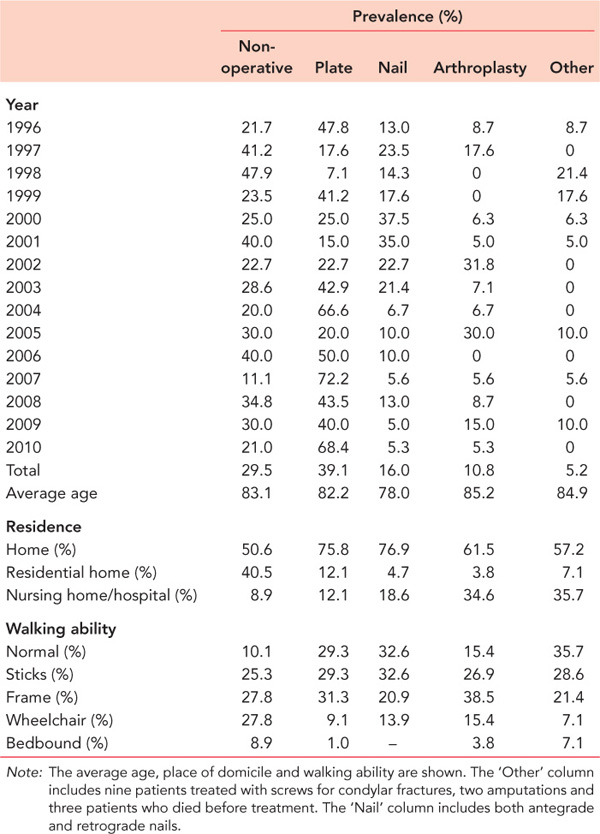
Stay updated, free articles. Join our Telegram channel

Full access? Get Clinical Tree








